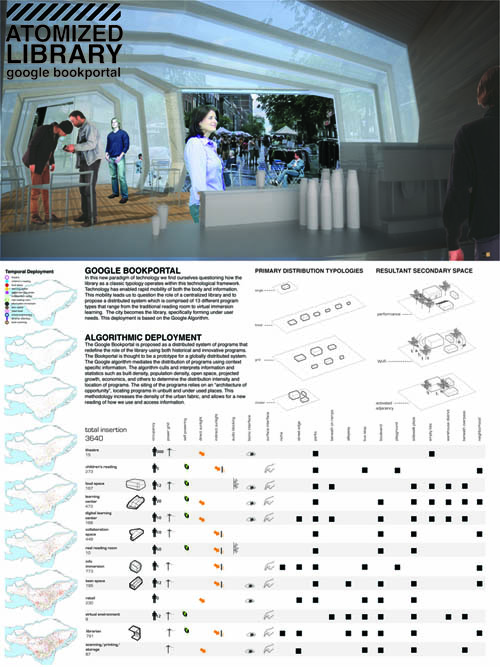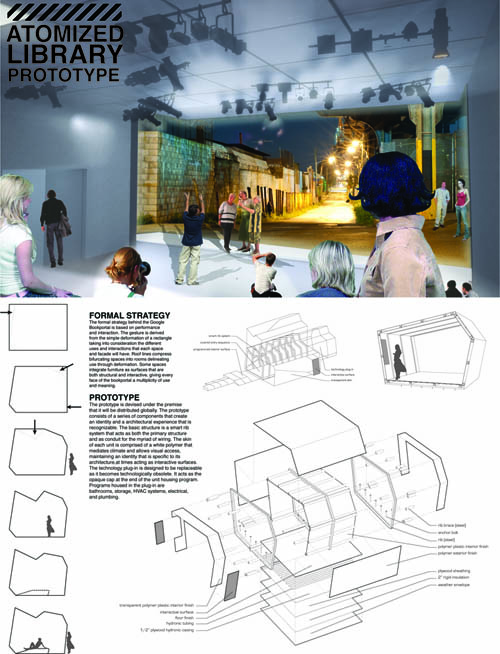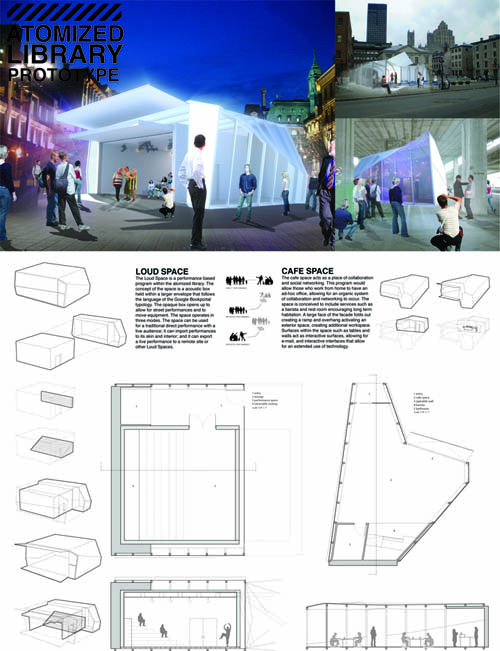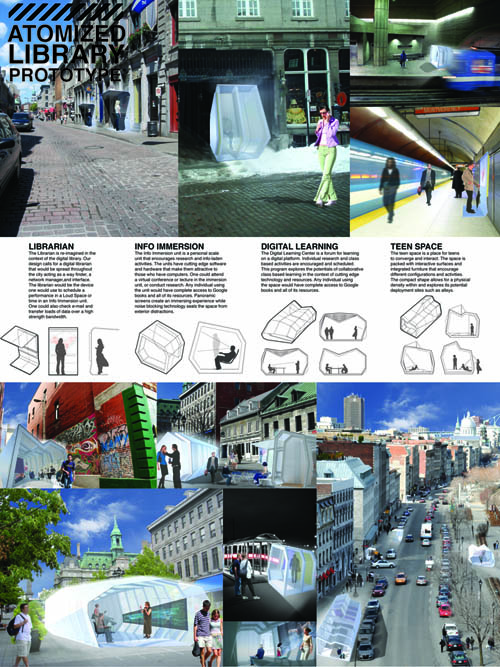The Atomized Library

[Image: The "Atomized Library" by Duncan Young and Brett Walters].
For a recent studio at the California College of the Arts (CCA) in San Francisco, taught by Douglas Burnham of envelope A+D, students Duncan Young and Brett Walters produced what they call "The Atomized Library." It was produced as part of an overall studio exploring the space of the public library in an age of rapidly changing information storage.

[Image: The "Atomized Library" by Duncan Young and Brett Walters].
The basic idea was to scatter smaller information spaces throughout the city: buildings, kiosks, cafes, computer labs, public-access WiFi envelopes, media production centers, "teen spaces," public meeting rooms, and more. Importantly, though, the entire point of Young's investigation was to ask what libraries might look like if information was no longer accessed through books.

[Image: The "Atomized Library" by Duncan Young and Brett Walters].
"This methodology," Young and Walters write, "increases the density of the urban fabric, and allows for a new reading of how we use and access information." His units would be particularly well-suited, he suggests, for "unbuilt and under-used" urban sites.

[Image: The "Atomized Library" by Duncan Young and Brett Walters].
Think of it as a network of partially prefab, rapidly deployable, plug-in, book-less micro-libraries, with potential for global distribution. EasyLibrary, perhaps.
In fact, it raises an interesting question: when it comes to public libraries, whether we're referring to New York City or Ciudade del Este, what is the architectural equivalent of One Laptop Per Child? Is the future of the community library a modular shed, or has an entire building type been made obsolete by handheld devices?
Larger versions of these images are available on Flickr.





Comments are moderated.
If it's not spam, it will appear here shortly!
This is a very interesting idea; As I work for a public library, one that will more than likely be discussed at work at some point.
I like the idea of having a lot of branch-mobile-sites like these for libraries, but also think centralized, book-filled libraries should never be completely erased.
There's a lot of people who like nothing more than holding a book or manuscript in hand and able to thumb through the pages themselves.
Also, librarians are an invaluable asset to the public--a link into a world of information that a computer would have a difficult time trying to imitate completely.
But, this doesn't mean Both types of information-accessing can't exist within a large city. They should be able to easily coexist and cooperate with each other.
I look forward to this retro-fitting of technology and information.
Interesting ideas here. I live in Madrid, where the Underground/Subway/Metro system hosts its own "minilibrary" branches.
Check them out:
http://tinyurl.com/yje2mxv
Cheers!
Given that "Young's investigation was to ask what libraries might look like if information was no longer accessed through books," I am still not sure what exactly those libraries would indeed look like, thought I am certainly intrigued by the concept! I see some CAD drawings of a guy in an angular-shaped room looking at the wall, is he looking at a screen? If there are no books in these libraries, what is there instead? Computers? Interactive multi-touch screens on the walls?
How would these libraries be different from just bringing your laptop to starbucks and using the internet there?
Also, there might be a cool application for the Gutenberg project here.
I have to say that this project is spot on. The concentrated attention required for true research or collaborative creation is fundamentally reliant on a sense of surroundings, whether you're writing a Proust thesis or day-trading. This is why many people that "work from home" can be found on their laptops anywhere but. Finding alternate contexts and actions within the arena of data immersion is the future of the library.
The library will not be as important as a data source in the coming years. More as a social institution, free public space, as a memory institution etc. In terms of data, it is more important how the data/info. is served to the users. The key to the success of the project is the question, how does it empower the users? what kind if information is it providing, and how? and where should such mini libraries be located. An important point to remember is the trust locals have in their public libraries; so we also have to ask how will co-location or partnerships with coffee shops and private bossinesses affect the communities image of a public library.
I am working on a similar project in the city of Delft, NL. Feel free to contact me - Aditya (adipawar@gmail.com).
Here's an idea - let's just eliminate all those pesky humans and let the machines run everything.
Seriously, if we're going to pull the people out of managing the library and turn the librarian into "the device one would use to schedule a performance in the Loud Space" (see Board 4) ... I don't want to live in that future, thanks.
Distributing access is an idea to be cheered. Turning curatorial control over to algorithms and "smart spaces" is dehumanizing, depressing, and dystopian.
Bill and Alexander, Thank you for your comments on our project. Just as a clarification, the idea investigated with this project was not how to eliminate existing libraries, although there are always new ways to look their function as well. Yes, there are those of us who will always want to hold a book, and in some situations I am one of those people. However, what Duncan and I were basing the project on was Google’s book scanning project and the company ideal of free information. Atomized specified programs that would be micro tailored to differing group needs would allow a sharing of information and offer the alternative of interacting with the social network, rather than technology separating and isolating the user. As with Google’s current model of operations, use would be free to the user and financed through their advertising business model. An additional draw to these units would be advanced cutting-edge technology based in the ‘plug-in’ which would be routinely upgraded: technology not available elsewhere. Hope that clarifies.
Post a Comment